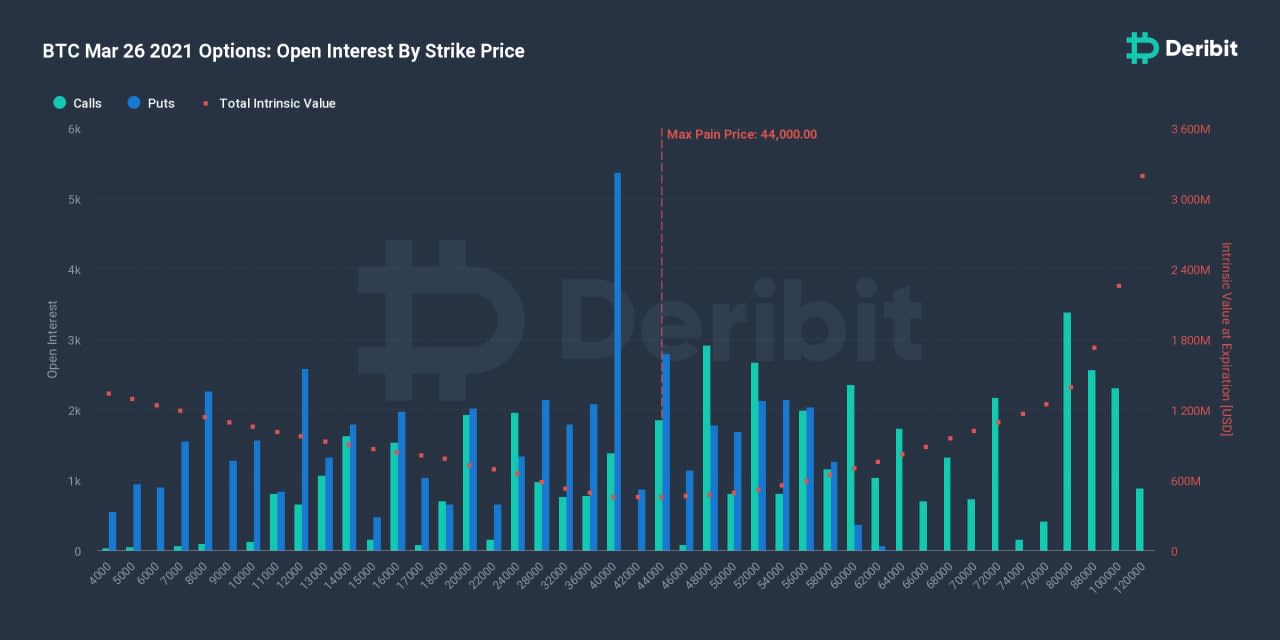Bitcoin Traders Brace for Record $6B in Options to Expire Friday

They call it “max pain” in the bitcoin options market: How to make one’s trading counterparty suffer the most.
Although the largest cryptocurrency was changing hands Wednesday around $56,500, traders were handicapping the odds of a plunge to about $44,000 by Friday, when a record $6 billion of options contracts is set to expire.
A drop to that price level would inflict “max pain” on buyers of options contracts, and it might be the most profitable price point for options sellers. It’s a remote risk, but not one to be discounted.
Related: Bitcoin News Roundup for March 24, 2021
The max pain theory states that the market will gravitate toward the pain point while heading into the expiry. That’s because sellers – typically institutions or sophisticated traders with ample capital supply – often try to push the price toward the max pain point by buying or selling the asset on spot or futures markets.
The bullish spin is that if bitcoin makes it through Friday without a major correction, a major overhang will be lifted.
“Max pain for the March 26 expiry is currently $44,000 on Deribit,” Luuk Strijers, CCO of Deribit, the world’s largest crypto options exchange by trading volumes and open positions, told CoinDesk. “That does not mean the market will move to $44,000 by the end of this week, but it does imply that after Friday this potential downward pressure no longer exists.”
Max pain is calculated by adding the outstanding put and call dollar value of each in-the-money (ITM) strike price. An ITM call is one where the strike price is below the spot market price, while a put is considered ITM when the spot market price is below the put option’s strike price.
Related: The Node: Beeple Sold Out. So What?
A potential unwinding of trades as Friday’s expiry approaches may inject some volatility into the market, according to Pankaj Balani, co-founder and CEO of Delta Exchange.
Carry trading, or cash and carry arbitrage, is a market-neutral strategy that seeks to profit from increasing and decreasing prices in one or more markets. It involves buying the asset in the spot market and simultaneously selling a futures contract against it when the futures contract is trading at a significant premium to the spot price. That way, savvy traders can lock in fixed returns, as the futures price converges with the spot price on the day of expiry.
“We also saw a lot of carry trades this expiry as the futures premium expanded from 15% to 25% per annum earlier this year,” Balani said, adding that 60% of the short futures positions opened in carry trades are yet to be rolled over to the April expiry. Rolling over short futures means carrying over bearish positions from the current expiry to the next month.
Expiry may aggravate potential sell-off
The rollover, however, may not happen if the futures premium shrinks in the next two days. In simple words, carry trades will be squared off: Short futures positions will be squared off or allowed to expire, and the long positions held in the spot market could be dumped, leading to increased price volatility.
Also read: This Ether Options Play by Institutions Has Lottery Ticket Potential
“If the premium on futures shrinks, then we can see the unwinding of the carry trade, which can increase short-term volatility on expiry day,” Balani told CoinDesk in a WhatsApp call.
“Traders have sold puts much more aggressively in this expiry,” Balani said, adding that if the market starts falling due to some reason, these short put positions will be squared off. That would add to bearish pressures around the cryptocurrency ahead of the expiry.




